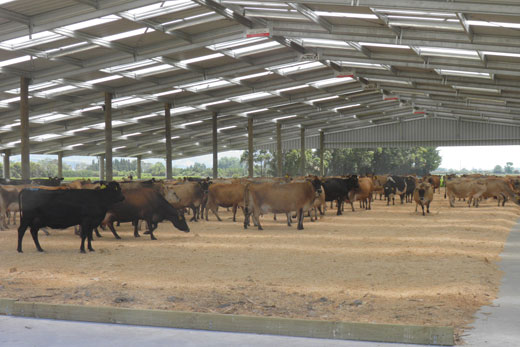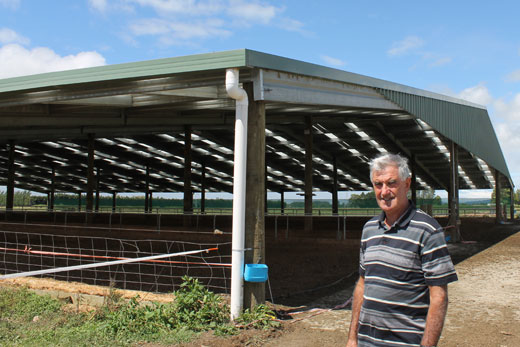A huge open-sided barn is the favourite place to be for the 500 cows on Dreamfields Farm, at Otakiri near Edgecumbe. It's pretty popular with the staff too.

Aztech Buildings carried out the construction of the barn on Bruce Wood's farm, which is popular with the cows.
Covering nearly half a hectare, the barn was built by Aztech Buildings for Bruce and Judy Woods about 12 months ago as a stand-off area to protect winter pastures.
'However, we've used it for all but a few months of the year, including in the summer, as a place to keep cows cool,” says Bruce.
That use wasn't something he'd factored in when planning and designing one of the first dairy housing bards in the district – but it proved especially valuable during last summer's drought.
'There's always an airflow through the barn and it's usually quite a bit cooler, maybe up to 10 degrees cooler, inside than out in the paddocks.”
The Aztech barn is also ideal for calving, providing a covered, well lit area for both staff and animals. With plans to grow the herd size, the 500-cow capacity barn may not be big enough and Bruce is considering how to accommodation a further 100 animals.
The welfare and health of 'the girls” which provide the family's income and lifestyle is always paramount for Bruce; and a regular drench and vaccination programme is in place.
Litter on the floor of loafing barns was thought to pose a risk of increased mastitis but the farm has low somatic cell count.
Bruce says regular mechanical raking of the saw dust in the barn keeps it clean and cows have regular teat spraying, using a WETiT system, even before calving. 'I really think this has made a significant difference to animal health. Being in the barn has also made the cows quieter, more content and easier to handle,” says Bruce.
The litter from the barn floor has not been changed since it was first commissioned 12 months ago but it remains dry, friable and odour-free.
Later this year the material, (an estimated 1000m3 of compost), will be removed and spread on paddocks to be used for growing maize for animal feed.
Dreamfields' pumice soils dry out in summer, but can be wet in winter because of a high water table. Since the barn was finished, Bruce has a no-pugging policy in place for pasture. Hands-on monitoring of soil health with a spade and no persistence issues with rye grass are other important areas of pasture management.
Building the large and very expensive barn is yet another progression made by Bruce in refining and sustaining the farming operation, which began with the purchase of the original farm in 1975.
'If you go back over 40 years the price of land has risen steeply, increasing the true cost of growing grass, as the yield of grass grown has not increased at a comparable rate,” says Bruce.
Rather than buy more land (although they have bought some), Bruce has turned his focus to producing more from the land Dreamfields has.
He was among the first in the area to invest in a pivot boom irrigation system using bore water to irrigate 72 hectares of the 159 ha farm, providing the ability to grow grass year-round. A new telemetry system is in place which automatically sends data to the Bay of Plenty Regional Council on the use of bore water on the farm, and refinements to the irrigation system means water use is even more efficient.
Always keen to innovate, Bruce currently supports a seed company trial of new pasture species on the property.
He has set a target of harvesting 20 t/ha per year of grass and a 30 per cent growth in milk production per year during the next four years, and believes that's achievable.
Last season, despite the drought, the 420 cows produced 174,000 kg/ms up from 144,000 kg/ms produced by 405 cows the previous season.
Bruce draws on his accountancy background to manage the financial sustainability of the farming enterprise, which includes operating within one per cent of the projected budget.



0 comments
Leave a Comment
You must be logged in to make a comment.